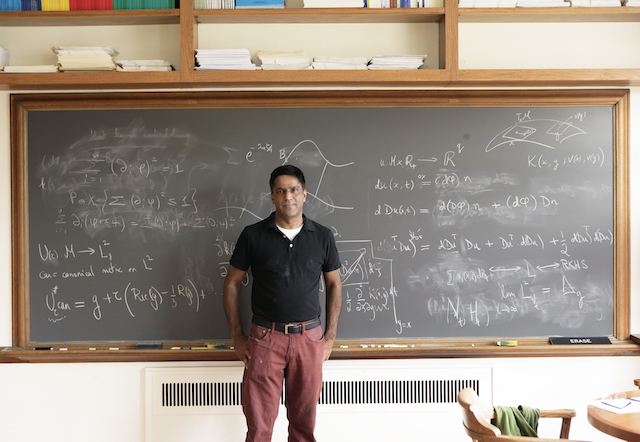
My initial interests were in dynamical systems, with applications to the statistical mechanics of disordered systems, especially the study of phase transitions. Since then I have worked in several areas, following problems where they lead. My primary goal at present is to contribute to the development of the mathematical foundations of artificial intelligence. This work includes rigorous analysis on embedding theorems, the dynamics of optimization by gradient flows, the construction of priors for geometric models, and a closer look at the evolution of mathematical thought and policy in these areas.
I am a theorist: I develop models along with algorithms and rigorous justification largely in the spirit of mathematical physics. Areas of interest include:
Phase transitions and non-equilibrium statistical mechanics.
Random matrix theory and the probabilistic analysis of numerical algorithms.
Statistical theories of turbulence.
Embedding theorems and their applications in geometry, learning and physics .
My primary current goal is the development of a probabilistic approach to the embedding theorems of Nash and Whitney. My fascination with these theorems is rooted in the conviction that embedding is best seen as a form of information transfer between a noise source and an observer and that the only fundamental limits on information transmission are those provided by Shannon's channel coding theorem. This idea is unexpected if one takes the historical view of these theorems, but it is stimulated by several recent developments in mathematics. These include analogies between embedding and turbulence, the challenge of constructing random geometries for several applications in the sciences, and the use of the embedding theorems in learning theory.
My ideals are those of a mathematical physicist. I am constantly amazed by the mathematical beauty of fundamental physical models. Dirac's dictum that all physical principles must have mathematical beauty, seamlessly coexists with Cantor's view that the essence of mathematics resides in its freedom. We have no understanding of why this is the case, but it is a gift of knowledge that belongs to us all.
I am also fascinated with the idea that biology can inspire nanotechnology. While self-assembly today is principally driven by experimental advances, it is a promising field for mathematical contributions.
I teach classes undergraduate and graduate classes in many areas of applied mathematics. In the past five years, I have developed several new classes that bridge traditional areas of applied mathematics (PDE, dynamical systems) with models and insights from information theory and learning theory. I am also deeply interested in revitalizing the humanistic tradition within mathematics.
In all my research work, I first develop ideas in the classroom with students and co-workers, developing lecture notes that are polished in each iteration of the class. I am interested in a few too many things for this process to be efficient, but time does provide simplicity of exposition. Click on the link above for lecture notes.
APMA 2190/2200 Fall 2019, Spring 2020, Fall 2022. Nonlinear dynamical systems.
APMA 1940/41 Spring 2017, 2018, 2020, 2022: Pattern theory (in my interpretation this is a constantly evolving course on math under the hood in AI and machine learning).
APMA 1710 Fall 2016, 2017 and 2019: Information theory.
APMA 1920/HIAA 1875 Fall 2023: Form and formalism (this seminar investigates several ideas at the interface between the humanities and mathematics, contrasting ideas of aesthetics, empathy and intuition in art history and math).
APMA 2821X Spring 2016, Statistical theories of turbulence.
APMA 2811O Spring 2015, Dynamics and stochastics (random matrix theory) .
As everyone who is involved in the publishing of mathematics knows, the cost of journals has skyrocketed, while most of the actual work involved in publishing (i.e. writing, editing and even typesetting papers) has been pushed onto authors.
The primary purpose of academic publication is the communication of knowledge not the protection of prestige. I only review or submit papers to low-cost journals.
I am also a correspondent for The Mathematical Intelligencer .
I am always happy to talk with undergraduate students at Brown. The best day to meet with me is on Friday.
If you're looking for an undergraduate research project with me, here are my parameters. I have advised several honors theses and I'd be happy to discuss this with you. My typical expectation is that you work with me for at least two semesters, commiting time equivalent to at least one class per semester.
I have no other research opportunities for undergraduates. In particular, I do not work with undergraduate students during the summer break, nor do I work with any students who are not enrolled at Brown University.
If you are a prospective student, and you'd like to work with me, please note that students at Brown are admitted to the graduate program, and are free to choose their advisor, so my "queue" should play no role in your decision to apply to Brown. Student plans often change (as they should) after some time in graduate school.
Image courtesy Jessica Wynne .